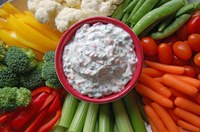Prairie Fare: Try These 5 Summer Food Safety Questions
(Click an image below to view a high-resolution image that can be downloaded)
By Julie Garden-Robinson, Food and Nutrition Specialist
NDSU Extension
Think back to high school for a moment.
Most of us took some kind of science course, maybe biology. Perhaps you took some science courses beyond high school. Maybe you majored in a science field.
In early days, do you remember learning about bacteria, yeasts, molds and viruses?
I don’t remember the emphasis on germs when I was young. Kids are becoming well-versed in microbiology these days.
Preventing the growth of bacteria, molds and other organisms is among the reasons we have refrigerators and freezers in our homes.
Without cold storage, the invisible intruders that can be present in our foods would make the foods inedible and potentially dangerous. Refrigerator storage slows the growth, and freezer storage stops it until thawing.
We cook our food to make it more palatable and also to inactivate bacteria. Food companies heat-process cans or jars of food so it is safe.
The warmth of summertime may beckon us outside to grill and/or dine. Foodborne illness cases tend to increase as we move food preparation outside.
Let’s try a few quiz questions to see what you know about microorganisms and ways to control them. The answers to these questions are based on recommendations from the U.S. Department of Agriculture and the Food and Drug Administration.
Questions 1: You tasted grilled lamb with rosemary at a restaurant and have decided to prepare lamb at home. To what internal temperature should ground lamb be cooked as measured by a food thermometer? How about lamb steaks?
A. 160; 145
B. 50; 130
C. 170; 125
Question 2: The outdoor temperature has soared to 95 F. You are setting out a picnic buffet under a shady tree. How long are the egg salad sandwiches safe without being on ice in a cooler?
A. 30 minutes
B. One hour
C. Two hours
Question 3: This potentially fatal form of foodborne illness has symptoms that may include double vision, drooping eyelids, difficulty breathing and swallowing problems. What foodborne illness has these symptoms, and what is the most likely food source of the bacteria?
A. E. coli gastroenteritis; ground beef
B. Salmonellosis; chicken
C. Botulism; home-canned vegetables
Question 4: You are staying at a cabin and decide to take a drink from a stream that looks clear. Less than a day later, you experience projectile vomiting, explosive diarrhea, headache, fever and chills. (In other words, you don’t want this to happen to you.) What organism is the most likely cause?
A. Norovirus
B. Salmonella
C. Trichinella
Question 5: Unfortunately, the ice in your cooler has melted and left a puddle of lukewarm water. Your macaroni and ham salad is floating in a plastic container in the water. You eat it anyway because you are hungry after hiking. About two hours later you experience intense stomach cramps, vomiting and diarrhea. Which type of bacteria is the likely culprit?
A. Salmonella
B. Staphylococcus
C. E. coli
Here are the answers, plus a little more information.
- Cook ground lamb to 160 and lamb steaks/chops to 145 with a three-minute rest. This is the same recommendation as we have for ground beef. Use a food thermometer to check internal temperatures.
- When temperatures are above 90 F, leave perishable food outside of temperature control for no more than one hour. Even better, keep your food in a cooler stocked with plenty of ice. Keep the cover on your cooler and place it in the shade. When traveling, keep the cooler in the passenger compartment of the vehicle.
- Botulism is most often linked with improperly processed home-canned food and it can be fatal or leave lasting health effects. Preserve food safely. All low-acid food (vegetables, meats and most mixtures of food) should be pressure canned for safety. Acidic foods such as jams, jellies and fruits can be canned in a boiling water-bath canner. See https://www.ag.ndsu.edu/food for research-tested food preservation information.
- Norovirus can be transmitted by water and food, and from person to person. We often hear about norovirus outbreaks associated with cruise ships. Be sure to drink safe (“potable”) water and to wash your hands and prepare food with safe water.
- Staphylococcus is the most likely cause. It grows well in creamy, protein-rich foods that have been handled by unwashed hands or in foods that have been temperature-abused. The toxin produced can cause symptoms in one to six hours. The symptoms among older adults, infants and immune compromised people can be severe.
Here’s the good news: No one has to experience these symptoms if proper food handling, preservation and storage procedures are followed. Search online for “NDSU Extension Fight BAC! Fight Foodborne Bacteria” (FN582) for more details about the four steps to food safety: clean, separate, cook and chill.
Here’s a recipe that makes use of some of summer’s bounty, the super-nutritious green veggies spinach and kale, along with carrots and bell peppers. Be sure to rinse leafy greens thoroughly under running water. This recipe also features yogurt, a food with “good bacteria” that will help keep your gut healthy.
Spinach and Kale Dip
16 oz. fat-free plain Greek yogurt
3 Tbsp. light mayonnaise
3 cloves garlic, minced
1/2 tsp. onion powder
1/2 tsp. garlic powder
1/2 tsp. dill
1 c. kale, finely chopped
1 c. spinach, finely chopped
1/3 c. bell pepper, minced
1/3 c. carrot, minced
Salt and pepper to taste
Add yogurt, mayonnaise and seasonings to a bowl and mix. Add chopped vegetables and stir to combine. Chill for two hours to allow the flavors to meld. Serve with crackers or chips.
Makes 14 servings. Each 1/4-cup serving has 35 calories, 1 gram (g) fat, 4 g protein, 3 g carbohydrate, 0 g fiber and 40 milligrams sodium.
(Julie Garden-Robinson, Ph.D., R.D., L.R.D., is a North Dakota State University Extension food and nutrition specialist and professor in the Department of Health, Nutrition and Exercise Sciences. Follow her on Twitter @jgardenrobinson)
NDSU Agriculture Communication - July 22, 2021
Source: Julie Garden-Robinson, 701-231-7187, julie.garden-robinson@ndsu.edu
Editor: Ellen Crawford, 701-231-5391, ellen.crawford@ndsu.edu




